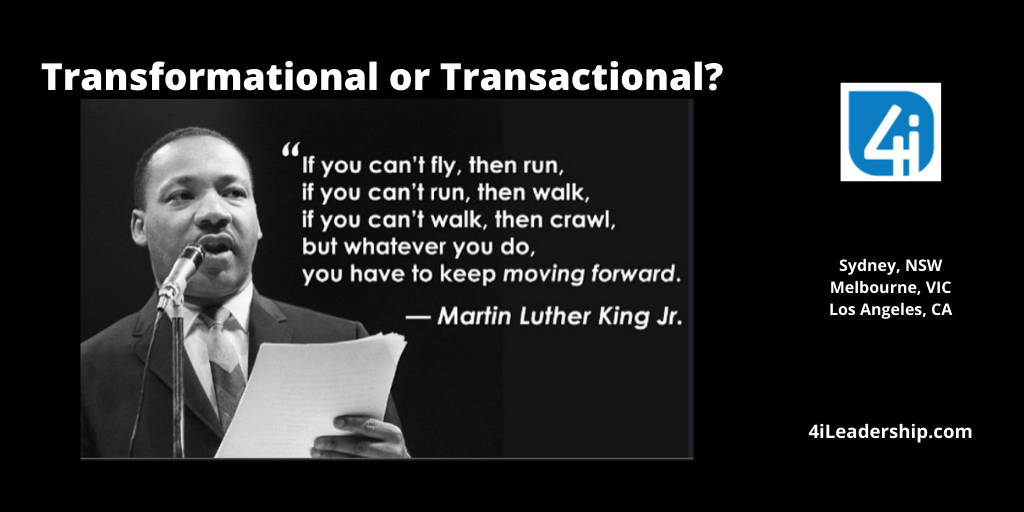
Are Leaders of High-Performance Teams More Transactional or Transformational?
The answer to the title of this article is most likely both. Tim Collings, the CEO of 4i Leadership, and I both believe, and academic research happens to back us up, that the best leaders use different styles based on the situation. Transactional and transformational leadership styles tend to be inherent in most leadership models. For instance, Situational Leadership by Ken Blanchard provides four quadrants of leadership moving from transactional through transformational leadership styles based on the situation and personal needs.
Transforming ourselves should feel like a natural process with beautiful results.
Transactional leadership was developed and defined by Dr. James Burns in 1978 as exchanges between leaders and followers that accomplish performance objectives, completion of tasks, maintain organizational structure, and direct behaviour toward the achievement of goals. Efficiency and process are the focus.
Transformational leadership was further developed and defined by Dr. Bernard Bass in 1985 as “one who raises the followers’ level of consciousness about the importance and value of desired outcomes and the methods of reaching those outcomes,” (p. 141). In practice, this refers to the ability of leaders to transform attitudes, cognition, and behaviour.
These two ‘spheres’ of leadership are well known and recognised in practice and debated and researched heavily in the academic world. The reason we’re covering them this week is that in the Performance Climate System (PCS) measurement tool of performance and culture, the system allocates development areas into transactional and transformational sections. When we apply this tool to teams, it measures where the primary focus of the leader and team is at a particular point in time. Often the results confirm HR or management suspicions or expectations of how the team is performing without needed guidance, coaching, or training. However, there are ways we can specifically target the low performing cultural or performance areas so the leader can develop the team into trailblazers that reach and sustain high performance.

In the transactional part of the PCS tool, in previous articles, we’ve covered goals, roles and processes. Goals and objectives are definitive and measurable which makes them transactional. Roles should be clear and defined for the individual, leader, and the team, as we explained in our article Will improving role definition really increase team performance?. Processes are usually linear and tactile and can be followed by direction and rules. Each of these is transactional because if an employee does “X” or follows processes “X then Y then Z”, and fills a specific role toward the targeted objective then a goal should be met. Each of these steps is transactional by design. In the book Flexible Leadership, efficiency can be increased by refining work processes, establishing norms and standard procedures, investing in specialized personnel, facilities, or equipment and organizing around strategy (Yukl & Lepsinger, 2004).
Transformational leadership as part of a model and as measured by PCS includes adaptability, connection, and resilience. As stated in the research paper Situational, Transformational, and Transactional Leadership and Leadership Development from the Journal of Business Studies Quarterly,
“Transformational leaders encourage open, honest, and timely communication and foster dialogue and collaboration between team members. They encourage the expression of different views and ideas. They act as catalysts, speeding up knowledge acquisition and distribution. By allowing the expression of different views and ideas, by challenging old assumptions and beliefs, and by stimulating new perspectives they enhance the process of information interpretation, as well. On the other hand, transformational leaders may facilitate the cognitive and behavioural changes in organizational members resulting from previous phases of organizational learning.”
Jim Allen McClesky, (2014)

The question is, in practice when does a leader choose between a transformational or transactional style? Here is what one needs to consider:
- Transactional Capabilities: talent, knowledge, skill, structure, process, instruction, role acuity, and goal achievement;
- Transformational Abilities: ability and agility in analytics, creativity, innovative expression of varying ideas and views, interpretation, knowledge acquisition as well as distribution, and work process or generation design and re-design agility.
If your employee does not have the talent, knowledge, or skill you’re probably going to have to use more transactional leadership until they have the knowledge and skill to accomplish the tasks required for their role. If your employee is struggling with the process, is not able to keep up with the changes in the process, and is not able to convey that knowledge effectively to other team members, then this employee probably needs both transactional help as well as training on how to utilize transformational principles.
If your employee has the talent, knowledge, skill, understands the organizational structure, processes, requires little instruction, is a mentor or trainer because they are good at the distribution of knowledge, questions and can reinvent the work process, or is good at design thinking, system thinking and has a growth mindset, then transformational leadership is the best method for this employee. Additionally, these employees may or may not have the adaptability or creativity needed to be innovative or be able to re-design workflow or roles. If an employee is struggling in any of these areas a leader would still utilize transformational leadership to grow them to this level. Subsequently, the leader will need to be more transactional in these functions until the employee develops the skill needed to be adept, highly innovative, and creative where the leader or organization requires for the individual and team.
Leaders should also be working these transformational principles on both their own cognitive and behavioural capabilities to effectively manage or lead more people and more work functions.

Another consideration is leader preference versus what the organization needs. Often employees newly promoted to manager often stay in the transactional mode because that is where they are most comfortable. They will naturally manage the details, process, and skill very closely and stay away from innovation, cognition, or behaviour development because it is unfamiliar, therefore, more uncomfortable. Then this leader is going to require some directive attention on learning how to be transformational and how the transformational principals that are different than what a transactional leader does.
Conversely, often more experienced managers or leaders want to stay in the transformational role because it is exciting and newer. However, they will not manage the human and machine mechanisms required as basic principles of their transactional portion of their responsibilities and will miss the need for transactional leadership attention. These high performers start seeing the productivity of the department decline even though they are adding great value in innovation, knowledge distribution, analyses, and design principles. 4i Leadership often experiences this when coaching leaders for companies of all sizes.

And so back to our findings when we work with the PCS Team Performance measurement tool. The leader’s focus is consistently in the transformational area even when measuring for transactional needs. The development opportunities more often lie, especially in the eyes of the team, in the transactional area. This means that there are great opportunities to apply focus back into goals, roles and processes, with immediately actionable steps and interventions which will return a performance uplift to the team. Excellence in transactional areas creates high performance teams. Then as the team and the leader return to focus on the transformational side, adaptability, resilience, and relationships, developing and maintaining excellence in these areas sustains high performance in the medium and long-term.
We’ll continue to examine each of these areas in length in the coming weeks. You can click here to see our previous articles on Goals, Roles and Processes, or here for more information on PCS and how we use the tool to develop high performance leaders and teams.

